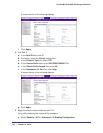
Chapter 11. CoS Queuing | 191
ProSafe M4100 and M7100 Managed Switches
CoS Queue Mapping
CoS queue mapping uses trusted and untrusted ports.
Trusted Ports
• The system takes at face value certain priority designations for arriving packets.
• Trust applies only to packets that have that trust information.
• There can be only one trust field at a time - per port.
- 802.1p user priority (This is the default trust mode and is managed through switching
configuration.)
- IP precedence
- IP DiffServ Code Point (DSCP)
The system can assign the service level based upon the 802.1p priority field of the L2
header. You configure this by mapping the 802.1p priorities to one of three traffic class
queues. These queues are:
• Queue 2. Minimum of 50 percent of available bandwidth
• Queue 1. Minimum of 33 percent of available bandwidth
• Queue 0. Lowest priority, minimum of 17 percent of available bandwidth
For untagged traffic, you can specify the default 802.1p priority on a per-port basis.
Untrusted Ports
• No incoming packet priority designation is trusted; therefore, the default priority value for
the port is used.
• All ingress packets from untrusted ports, where the packet is classified by an ACL or a
DiffServ policy, are directed to specific CoS queues on the appropriate egress port. That
specific CoS queue is determined by either the default priority of the port or a DiffServ or
ACL-assigned queue attribute.
• Used when trusted port mapping is unable to be honored - for instance, when a non-IP
DSCP packet arrives at a port configured to trust IP DSCP.


















